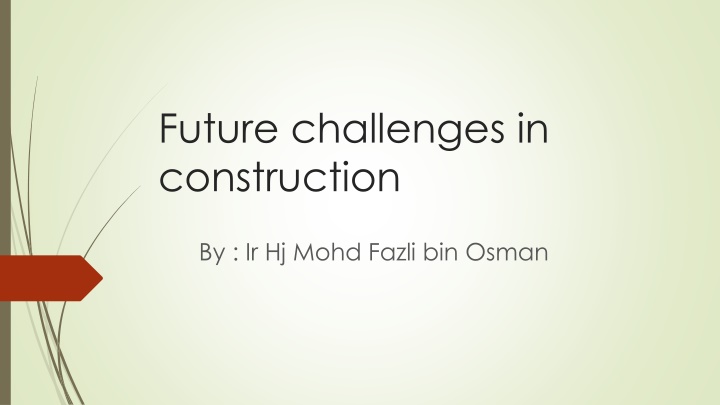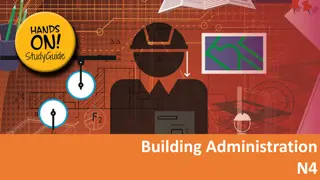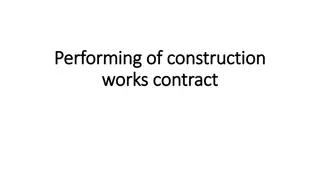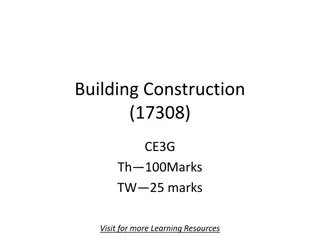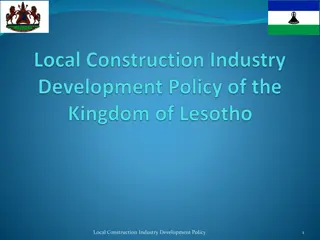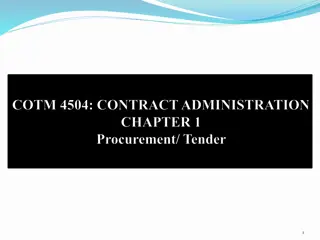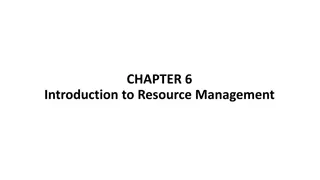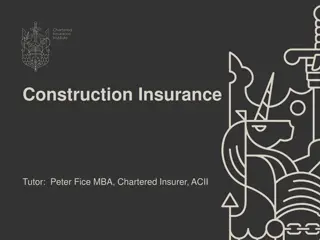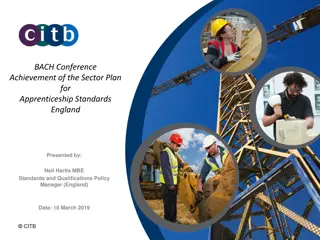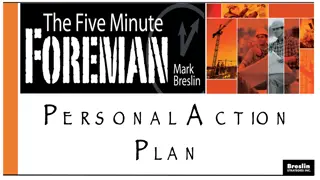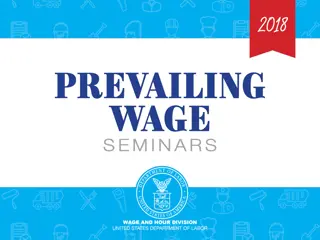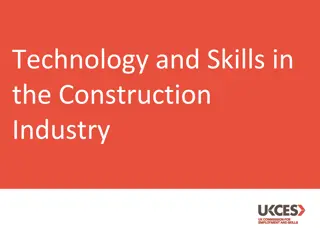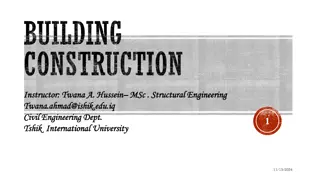Challenges and Opportunities in Construction Industry
The construction industry faces various challenges like workforce considerations, safety, time constraints, and non-construction issues such as legal matters, regulations, and environmental concerns. Overcoming these challenges through innovative technologies and skilled project management strategies is crucial for success in this sector.
Download Presentation

Please find below an Image/Link to download the presentation.
The content on the website is provided AS IS for your information and personal use only. It may not be sold, licensed, or shared on other websites without obtaining consent from the author.If you encounter any issues during the download, it is possible that the publisher has removed the file from their server.
You are allowed to download the files provided on this website for personal or commercial use, subject to the condition that they are used lawfully. All files are the property of their respective owners.
The content on the website is provided AS IS for your information and personal use only. It may not be sold, licensed, or shared on other websites without obtaining consent from the author.
E N D
Presentation Transcript
Future challenges in construction By : Ir Hj Mohd Fazli bin Osman
Content Introduction Challenges Malaysia s Initiatives
Introduction In the years ahead, the construction industry will have to overcome various challenges, be it direct or indirect. Technocrats associated with the construction industry need to employ innovative technologies and skilled project handling strategies to overcome these challenges. A glance around and the wonders of civil engineering glares at us; a house here and a flyover there; a highway here and a metro line there. The green splash of nature is slowly converting into a concrete boulevard, thanks to the construction industry.
The influx of various new technologies and deployment of project management strategies has made it possible to undertake projects of mega scale. Investment in this sector has been found to contribute significantly to the GDP of the country. Gross Domestic Product (GDP) is the best way to measure a country s economy. It is one of the primary indicator use to gauge the health of the country s economy
Country Construction Sector Contribution to country s GDP (%) India 10 UK 6.4 Australia 8.5 Indonesia 10 Malaysia 4.5
However, in its path of advancement, the industry has to overcome a number of challenges, some new and some old. Many of these challenges are a direct result of construction operations, while others a result of indirect, peripheral activities. A surprising number of challenges are not construction issues but must be addressed and managed to ensure project success. Some of the construction issues include workforce considerations, safety, time constraints, and the changing nature of the work.
Non-construction challenges that are part of the business landscape include legal issues, government regulations, environmental concerns, and sociopolitical pressures. Business that fail to take the challenges seriously, however will face uphill battle for viability.
What are the challenges? 1. Project Performanc e 7. 2. Project Management Compliance 6. Embracing disruption and readiness for the digital future 3. Skilled Labor Shortage 5. Poor Productivity 4. Sustainability
1. Project Performance The opportunities in construction are growing, but so is project complexity. With companies already operating under razor-thin profit margins, a single production surprise can wipe out profits for the whole company. Design complexity compounds this problem. As designs become larger and require greater efficiency, construction companies struggle to keep up.
The lack of on-time and on-budget projects is telling. The 2015 KPMG Global Construction Survey found that more than half of all construction companies experienced one or more underperforming projects in the previous year.
2. Project Management Construction as such, is a complex array of interdependent activities that some would say is at best, an organized chaos. The very nature of construction introduces challenges typically not encountered in other industries. The work is often seasonal and involves functioning in remote sites with accessibility problems. There may be difficulty in applying automation and requires adoption of technical innovation and the costs can vary as per the conditions.
The product can be of mindboggling size, cost, and complexity and also the work is not performed in controlled conditions, therefore highly impacted by weather and other environmental conditions.
The management of construction projects requires knowledge of modern management as well as an understanding of the design and construction process. Construction projects have a specific set of objectives and constraints such as a required time frame for completion. The Great Pyramids, the Hanging Gardens of Babylon, and the ancient cathedrals of Europe did not rise up haphazardly. From start to finish, precise coordination was required to complete these massive projects that often stretched across decades and generations.
Construction managers plan and coordinate such construction projects. She/he must understand and navigate the project through its realities and master the obstacle thereby gaining an edge over the market. A capable project manager must understand the business, legal and social aspects of construction and be determined to convert risks into opportunity. He must adapt to the changing business, social, legal and sustainable environment and lead the organisation through the challenges it faces.
3. Skilled Labor Shortages The construction industry is bracing for a dramatic reduction in workforce. The Associated General Contractors of America (AGC) found that 74% of the total respondents believe there is a crunch in skill trades, and 53 percent said they were unable to hire construction professionals such as supervisors, estimators, and engineers. The U.S. construction market consisted of two generations: the traditionalists and baby boomers. Now, the workforce has split into four generations: traditionalists, baby boomers, Generation X, and millennials.
This present labor diversification is a challenge because of stark differences in work ethic, attitude, outlook, and behavior between the generations. Traditionalists have nearly all left the workforce and baby boomer retirement is in full swing. By 2020, millennials are expected to represent half of the global workforce many with little to no experience or interest in the construction industry The combination of increasing project complexity and decreasing experience is a risk multiplier, increasing the risk of deliverable delays, quality construction problems, and employee safety concerns.
4. Sustainability The construction industry is the top global consumer of raw materials. The industry generates between 25 to 40 percent of the world s carbon emissions. This volume of natural resource utilization is not sustainable and could compromise the environment for the sake of growth. Achieving targets for global carbon dioxide emissions reduction will be a major challenge for the construction energy in rapidly developing countries. Smart planning and sustainable design could reduce energy consumption and pollution, but require a new approach to project management an approach that the construction industry on a whole is not yet prepared to undertake.
5. Poor Productivity and Profitability Currently, the barriers to entry in construction are low, creating a saturated marketplace with heavy competition. This competition is shrinking profit margins and constraining essential reinvestment in new technology and better business practices. Stagnant construction labor productivity is compounding this problem. This lack of productivity is reflected in the bottom line, where typical margins for construction companies range between 2 and 8 percent. Consequently, construction companies find themselves trapped between shrinking profit margins and stagnant productivity, unable to generate the profit necessary to invest in critical technology
6. Embracing Disruption and Readiness for the digital future. The construction industry is at an inflection point, analogous to the move from landline telephony to cellular technology. Digital technologies are disrupting the industry, providing new opportunities to address the challenges of poor profitability/productivity, project performance, skilled labor shortages, and sustainability concerns. Digitization of the construction industry is not a question of if or when the changes are happening now.
The industrialization of construction and the application of proven manufacturing technology and best practices will help companies drive reliable outcomes and improve margins. Digitization will increase productivity, eliminate waste, and mitigate the adverse impact of on-site surprises. Digitization will change almost everything, including the competitors and the barriers to entry. The end result: a more productive and profitable industry that builds more sustainable assets. Construction companies must take steps now to join the digital future and stay ahead of the competition or risk being left behind.
7. Compliance Government and lawmakers impose industry legislation for a reason, but it is sometimes difficult to see past the red tape. Industry legislation is a major driver for change in a number of different sectors. With safety engineering, H&S, employee rights and numerous other business management practices affected, construction companies can often find the red tape constrictive and counter-intuitive. While some of these issues may not materialize for years to come, many others are more than likely to cause imminent concern construction firms.
What about Malaysia? Malaysian construction industries are tackling the challenges through CIDB construction Industry Transformation Program (CITP) initiative. CITP initiative have 4 strategic thrust as follows: Quality, safety & professionalism Environmental sustainability Productivity Internationalisation
Increase emphasis on quality and implement quality assessments Improve workplace safety and workers amenities Improve ease of doing business by addressing regulatory constrains Promote and raise awareness of CITP initiatives Enhance integrity and increase governance Quality, safety & Professionalism Drive innovation in sustainable construction Drive compliance to environmental sustainability ratings and requirements Focus on public projects to lead on suitable practices Facilitate industry adoption of sustainable practices Reduce irresponsible waste during construction Environmental Sustainability
Continue investment in human capital development in construction Enhance control and balance of workforce supply Accelerate adoption of IBS, mechanization and modern practices Roll out technology advantage across project life- cycle Enhance availability of strategic information via National Construction Industry Information Centre (NCIIC) Advance SME/Bumiputra capacity and capability- building Productivity Internationalise construction practices and standards Strengthen access to financing for Malaysian champions going abroad Support consortia formation and strengthen overseas market intelligence Intensify contractor s capacity and capability building. Internationalisation
Let us look at past organization that is similar to JKR. Looking at the organization stand at any given moment which necessitate to anticipate effects that changing economic conditions, new rivals and market dynamics is a major threat to your ability to compete for business.
Australia Public Works Department (PWD) Formed :1stJanuary 1901 Dissolved :31stDecember 1984 Superseding agency : Building management authority Jurisdiction : Government of western Australia Public Works Department (PWD) are the State Government Agency of Western Australia which was charged with providing and maintaining public infrastructure such as dams, center supply, school, hospital, harbor and other public building. The department is no longer operational, having its responsibilities reassigned to other state government and corporate entities
New Zealand Department of Public Works often referred to as Public Works Department Formed 1876 Disestablished and privatized in 1988 When privatized the corporation have 2 main subsidiaries, work consultancy services and works civil construction. These were sold in 1996 and became OPUS international consultants and infrastructure respectively, and the corporation were disestablished.
United Kingdom Formed 1943 during world war 2 1962 renamed as ministry of Public Buildings and Works 1972 most former works function were transferred to the largely autonomous property service agency (PSA). Subsequent re-organisation of PSA into Property Holdings was followed by abolition in 1996 when individual Government departments took on responsibility for managing their own estate portfolios.
Singapore Public Works Department of Singapore formed in 1946. Infrastructure and building development. PWD Singapore was incorporated in 1999 under Temasek Holdings. 2002 renamed CPG corporation and 1 year later became part of the Downer EDI group. 2012 Downer EDI was transferred to China Architecture Design and Research Group (CAG)
Malaysia PWD was born 1872 PWD Federation of Malaya was formed in 1948 Later as JKR Persekutuan Tanah Melayu and finally JKR Malaysia.
Observation 1 From the above scenario, it can be observed that in meeting the challenges of the construction industries, these organization have adopted certain standard and reengineered themselves. These reengineering is done in the context of changing economic conditions and market dynamics in order to alleviate the competitive ability of the organization to compete for business.
PWD Singapore is a glaring example. From a government organization, it become a corporate body under Temasek Holding and later CPG corporation. It is one of the leading development professional in Asia-Pacific region providing building and infrastructure development and management service which comprise master planning, urban design, green design, architectural, engineering design and consultancy, project management, construction management to facilities management services.
Observation 2 Another thing to note is that, most of the PWD organization started with D.I.Y. Later to meet the changing economics conditions and market dynamics, the modus operandi of this organization evolved. Thus introduction of the outsourcing concept. Now we have suppliers , skill workmen, contractors, consultants etc i.e the ecosystem of the construction industry. The PWD s role has change to that of consultancy and project management. Some PWD s organization went on further to become corporatize and privatized entity. Their business is still engineering business.
Observation 3 JKR Malaysia is no exception. In meeting the changes of the construction industry. JKR Malaysia too has her share of the rollercoaster ride. Massive road building plan to open up rural Malaya. Self-contained work team formed (NST, 19.6.1960) PWD comes under review to speed up government projects. (The Strait Times, 25.12.1981) Dasar Pengswastaan Negara, 1983. Many ambitious and service professionals left JKR for the private sector . 1994 paper on corporatization of JKR, was sent to cabinet. The proposal was rejected. The paper was prepared by JKR/Arthur Anderson.
Corporatization of state water department 1990s The privatization of Institut Kerja Raya Malaysia (IKRAM) 1997. During Tan Sri Zaini tenure as KPKR he introduced Self contained team for small projects to speed up projects delivery. Privatization of federal road maintenance, 2001. Formation of National Water Services Commission, 2007.
Contd During Dato Sri Wahid tenure as KPKR. Change or die . Hence the introduction of matrix Organization, 2007. Restructuring of JKR Malaysia Headquarters, 2014, with emphasis on the following: Project Based to Asset based organization Total asset management. Life cycle cost Hybrid matrix improving delivery. Going forward as Government Technical Advisor.
JKR stigma The design does not complete on time The tender does not execute as schedule Pre- Tender Lack of communication among stakeholder Lack of coordination among stakeholder. The project does not complete on time as schedule The project need extension of time in order to be completed Post- Tender The quality of construction and installation does not meet the good engineering practice and functional requirement. Discrepancy and error in construction drawing
JKR strategies and initiatives to enhance effectiveness of project delivery. Acquisition Categorization (ACAT) Gateway PM Competency Framework PM Tools and Methodologies Project Implementation Strategies
Contd Building Information Modelling (BIM) JKR Strategic Themes Outstanding Project Delivery Co-creative Customer Experience Centre of Technical Excellence Leading Sustainability Innovative Organization.
For us to ponder. What JKR can do other people also can do. They can do better than JKR What value added does JKR have in order for JKR to be The Choice Consultant. What will JKR be beyond 2020???
The organization will not get better by chance, it will get better by CHANGE. To improve is to change. To be perfect is to change often.
